Affiliate disclosure: This post may contain affiliate links. Please see our Privacy Policy.
Violet jelly is an easy homemade flower jelly that will add stunning color to your toast, biscuits, and scones. Believe it or not, these bright spring blooms taste like fresh berries, making an exceptionally jelly long before the first fruit harvest of the season.
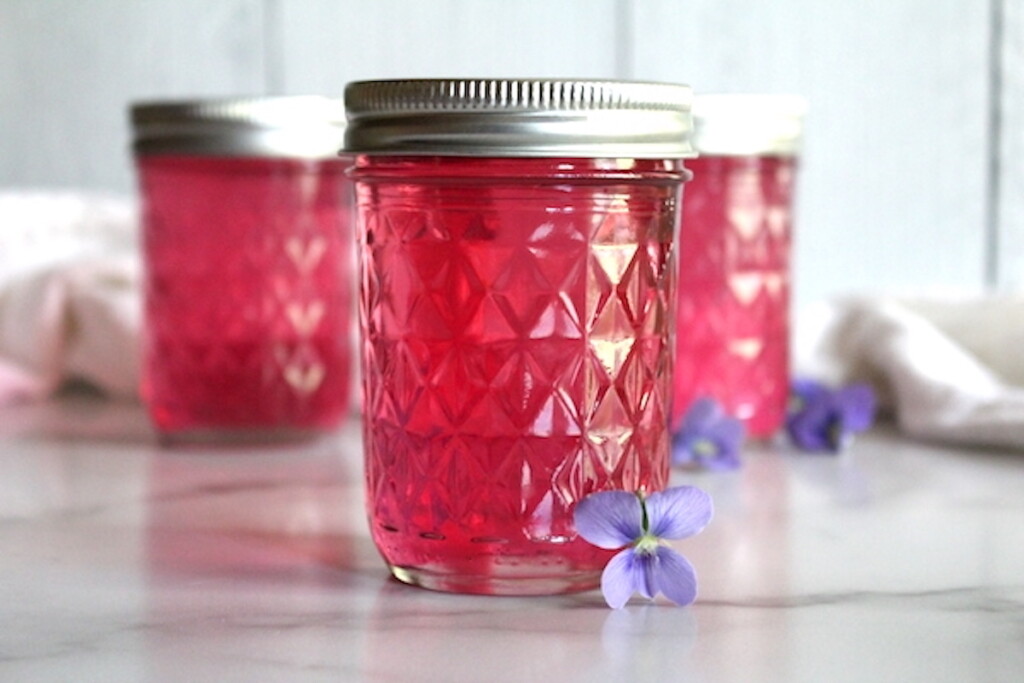
This past year kept us (and everyone else) at home more than usual, and it seemed like the perfect opportunity to make a project out of all the tasty edible flowers growing all over the yard by making flower jelly.
We started with dandelion jelly, which tastes like honey and sunshine, and with that success, the littles and I started making floral jellies out of just about all the tasty edible flowers we could get our hands-on.
Many, I’ll admit, were underwhelming. I don’t really need to make fireweed jelly or bee balm jelly again. Others were amazing, and we absolutely loved this violet jelly, as well as forsythia jelly, apple blossom jelly, and chamomile jelly.
We even tried out savory jellies like a spicy nasturtium jelly and a savory chive blossom jelly, both of which were surprisingly good with cheese and crackers.
Still, my kids favorite was this wild violet jelly. Believe it or not, violet jelly tastes like fresh spring berries rather than flowers!
Sweet and floral, with hints of blueberry and raspberry, wild violet jelly is going to be on our list each spring from now on! (And if you don’t have wild violets, you can also make a version with garden violas, and Pansy Jelly is pretty darn good too.)
(I’ve been asked many times, and no I don’t sell or ship jellies, but there are quite a few small makers on Etsy that sell it. If you’re looking to taste violet jelly without all the work of making it yourself, you can support these hardworking home canners at the same time. They are also people selling violet plants from the common wild violet, so you can grow your own.)
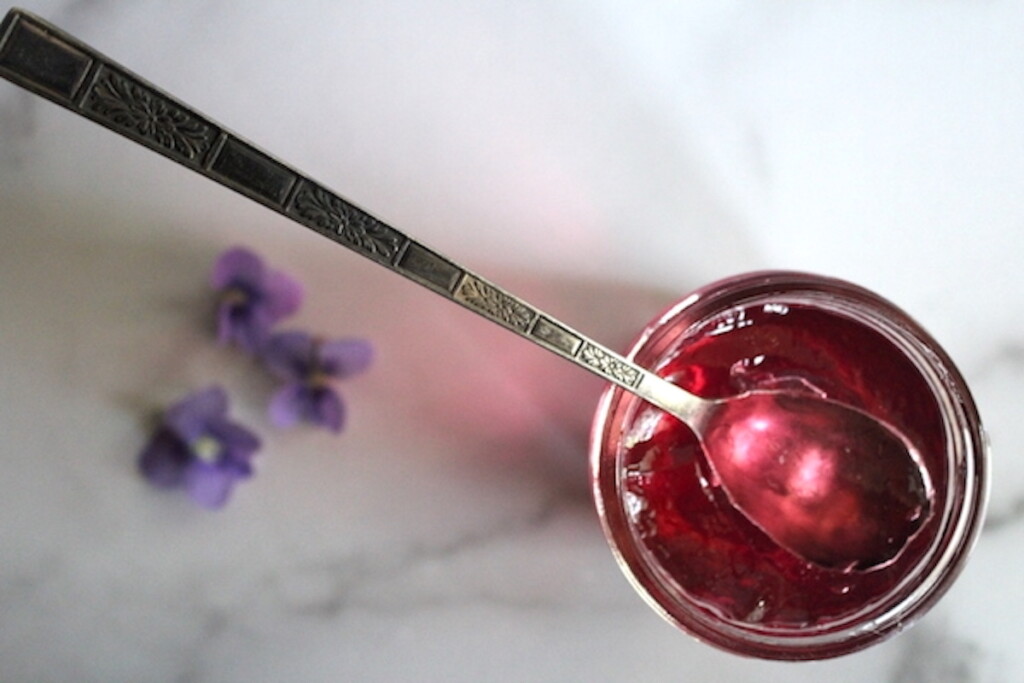
Identifying Wild Violets
Wild violets are pretty easy to identify, and they’re incredibly common. They prefer shady wet spaces, and you’ll often find them tucked into corners of your lawn near trees or on the north side of the house.
Here in Vermont, they grow wild near woods edges and bloom in late spring or early summer (May or June). In warmer areas, like the pacific northwest, they bloom as early as Mid-February.
My mom even has them in the high desert of California, where the seeds came in the pot along with a few fruit trees she planted. They don’t do well in the desert generally, given they like moist shade, but she attached drip irrigation to each of her trees.
They’re now all surrounded by a carpet of wild violets that bloom all year round, right through the mild California winter.
The leaves of violets are a distinctive dark green heart shape, that’s a deeper shade of green when they’re deeper in the shade (in sunnier spots the color washes to a lighter green shade). The flowers themselves have 5 petals in a rough star shape and can be anywhere from deep purple, to violet and white.
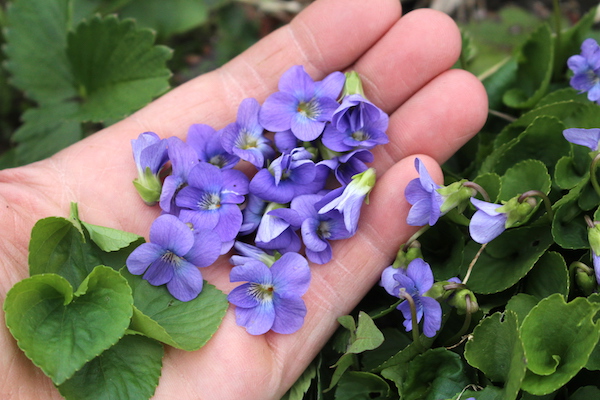
Medicinal Uses of Violets
While all parts of the wild violet plant are edible, it’s important to note that it’s also used medicinally. The actions are all relatively mild, so the quantities consumed in a bit of homemade violet jelly won’t really have much in the way of effects.
Historically, violet has been used as a respiratory herb (expectorant) and to treat hacking cough (the leaves, which contain soothing mucilage). It’s also used as a lymphatic tonic, to help with lymphedema and breast issues.
If you’re curious about the medicinal uses of violets, I’d suggest reading this article by the chestnut school of herbs, which covers both the edible and medicinal uses of violets quite comprehensively.
The main thing to know is that violets can be a very mild laxative, so don’t go eating a whole jar of violet jelly in a sitting. (Even that likely won’t have much impact, as it’s equivalent to a single cup of violet tea, which is well below a therapeutic dose.)
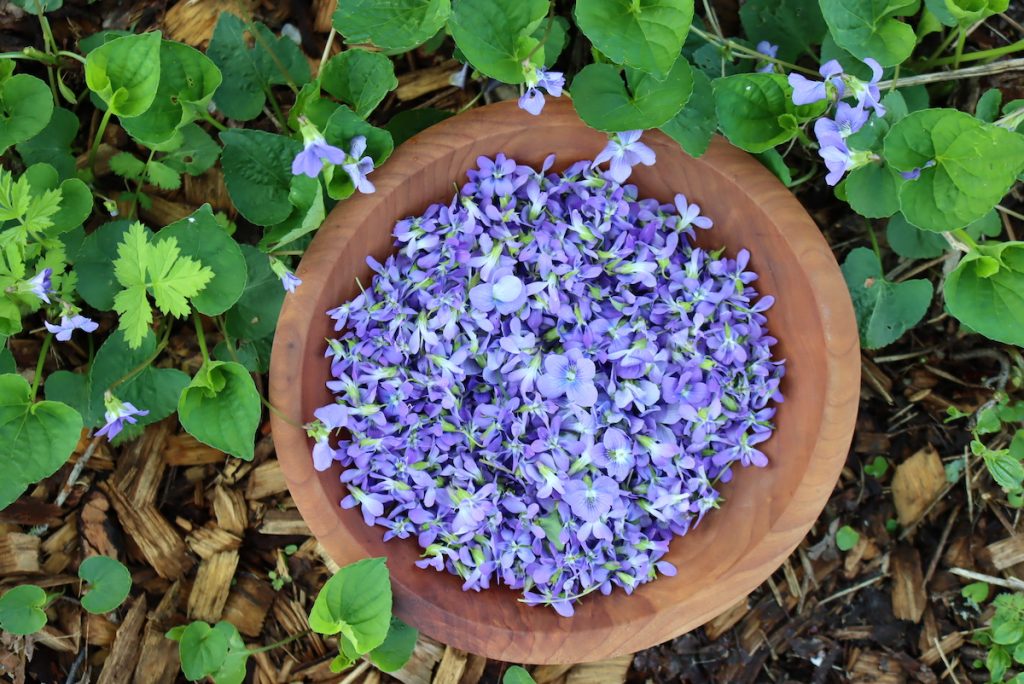
Harvesting Wild Violets
Making violet jelly starts with harvesting violets. I put my little ones (ages 2 and 4) to work and they entertained themselves for at least an hour harvesting a few cups of violet flowers.
Violets are prolific, but their flowers are quite small and it takes a while to harvest a meaningful amount. (If you do end up with a large harvest, there are plenty of other wild violet recipes to try, including violet wine!)
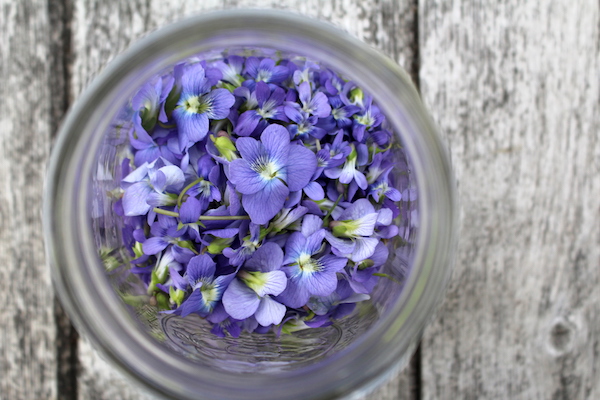
For a batch of violet jelly, you’ll need about 2 cups of violet flowers (loosely packed). A batch is 4 cups of jelly or 4 half-pint (8 oz) jars.
If you want to make it easy on yourself, harvest them right into a quart mason jar and stop about halfway full.
The next step is pouring 4 cups of boiling water over the flowers to make violet tea, which you can do right in the mason jar.
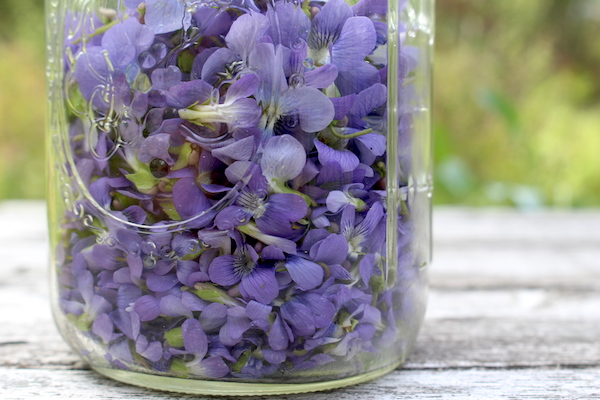
Preparing Flowers for Violet Jelly
When you pour boiling water over the violet flowers you’ll likely get a surprise…a greenish or turquoise-colored tea. That’s not exactly the bright pink color of the finished violet jelly, so what’s going on here?
The compounds that give violets their color actually change color in the presence of acids, like the lemon juice used in canning and jelly making.
Most fruits are acidic, and that low pH makes them perfect for water bath canning. It also brings out the sweet flavor of their natural sugars, and makes a fruit taste like fruit. Finished violet jelly tastes like fresh berries, and I imagine that’s because the same compounds that give them their color also color blueberries and blackberries.
(Both blackberry and blueberry juice will also take on a pink color when you add lemon juice. I actually add a bit of berry juice to my lilac wine, since lilacs don’t give up their color easily. It gives the whole beverage a stunning pink/purple color.)
Even if you’re thinking a turquoise jelly would be pretty neat, it won’t stay that way long. The pectin used to set the jelly actually contains citric acid to help activate the pectin, so no matter what you do it’ll be a pink/purple jelly.
Enjoy the unique color or turquoise violet tea while it lasts…
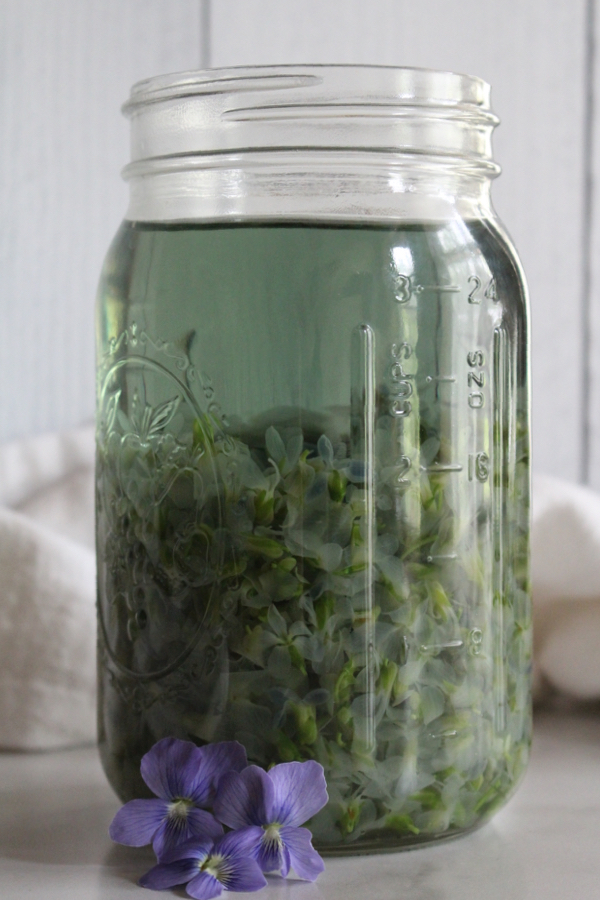
After making the violet tea, the next step is to add lemon juice (or citric acid). I think the lemon juice compliments the flavors of the flowers beautifully, but if you want a “pure” violet flavor you can use citric acid instead.
Citric acid is substituted for lemon juice at a rate of 1/4 teaspoon of citric acid powder per 1 tablespoon of lemon juice.
This added acid helps to contrast the sugar in the jelly (thus dramatically improving the flavor of any jelly, floral or otherwise), and it also lowers the pH to help the jelly keep (whether it’s canned or not).
It’s really neat to watch the color transform as you pour the lemon juice into the violet tea. It’s a neat little feat of chemistry as the pink curls around the jar.
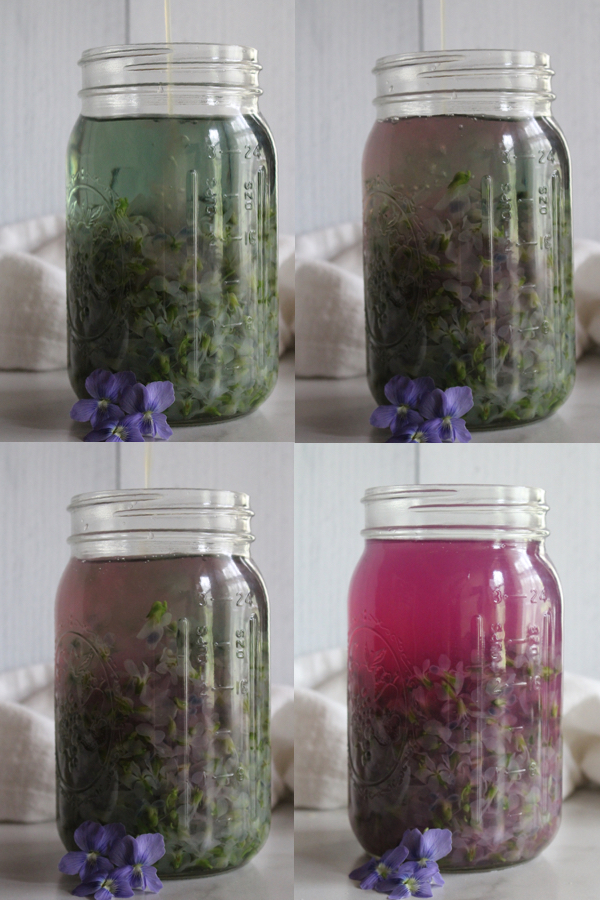
How to Make Violet Jelly
At this point, you should have a violet tea made from 2 cups of violet flowers and 4 cups of water. You’ve added lemon juice (or citric acid) and listened to your little ones (or friends) ooh and ahh at the color-changing magic.
Now it’s time to turn this into jelly.
The process is pretty straightforward, but the order of operations is important. I’m using regular powdered pectin, which is pretty standard and is made by many brands, but this happens to be a box of Sure-Jell, but Mrs. Wages and Ball Canning also make equivalent powdered pectin.
(Avoid anything labeled “no-cook freezer jam pectin,” as it doesn’t work the same way, and it’s much less useful. Even if you’re making a freezer jam instead of canning, I’d suggest using the real stuff as the finished texture is better and the process is more intuitive.)
With powdered pectin, you cannot add the sugar at the beginning. If you do, the jelly won’t jel. (Liquid pectin is just the opposite, and is added at the end.)
Strain the flowers out of the violet tea and pour it into a deep saucepan. Add the powdered pectin (and lemon juice if you didn’t already). Bring the mixture to a hard boil for 1 minute, then add the sugar.
(Note: The color will change even further when you add the powdered pectin, as it also contains some citric acid.)
Return the mixture to a boil for 1 minute, before ladling into jelly jars leaving 1/4 inch headspace.
(If using liquid pectin instead, use 7 cups sugar to 4 cups violet tea(with lemon juice added). Bring the tea and sugar to a boil, then add the pectin at the end and stir it in. I generally avoid liquid pectin because it requires astronomical amounts of sugar to gel, nearly a 2:1 ratio of sugar to liquid.)
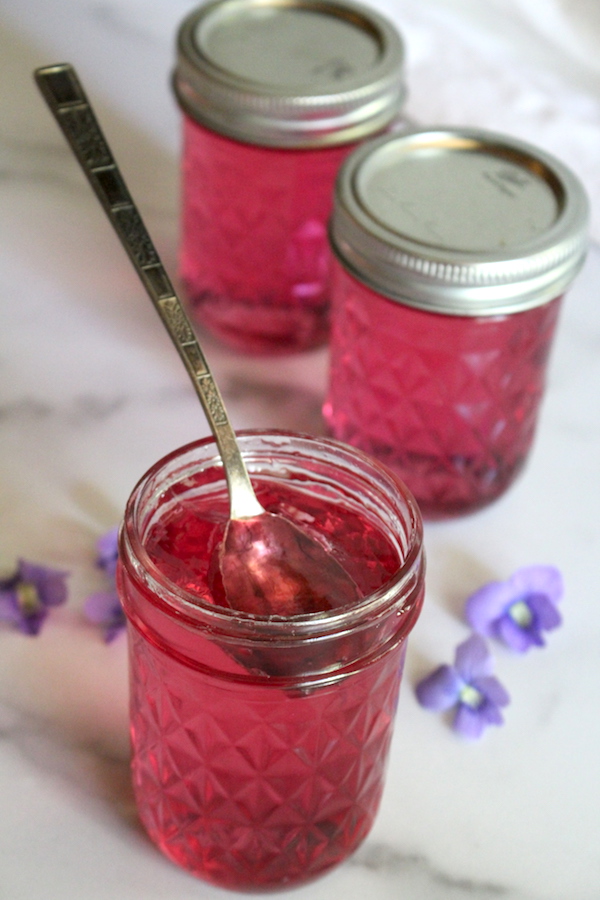
Violet Jelly Variations
I personally love violet jelly just the way it is but feel free to experiment a bit to match your tastes.
You can make a low sugar variation by using low sugar pectin, which is made by just about every pectin maker and each has its own specific instructions.
I like Pomona’s Pectin when I’m making low-sugar recipes, but be sure to read the slip that comes in the packet as that pectin works differently. Follow their instructions for mint jelly, as it’s also a herbal tea made into a jelly and it’ll work the same way with their pectin.
Adding other edible flowers, or a bit of fruit is an option too.
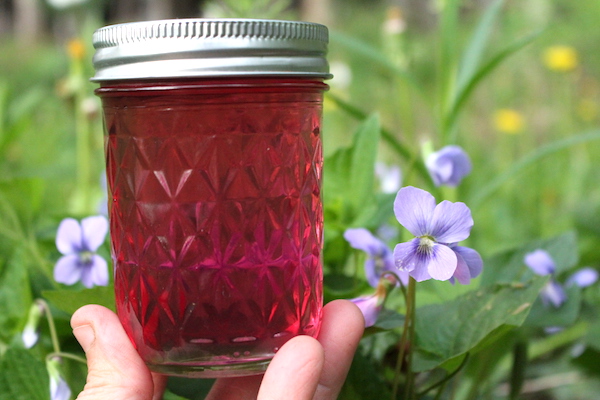
Canning Violet Jelly
Canning is completely optional and simply allows you to enjoy violet jelly year-round (or pack it up and give it as shelf-stable gifts). You can always make this as a refrigerator jelly, in which case, you’d just need to keep the jars in the refrigerator and use them within a few weeks.
My preference is always water bath canning because it lets me enjoy all the flavors of my yard in the winter months (when I’m desperately missing them). If you’ve added the recommended amount of bottled lemon juice (or an equivalent amount of citric acid), the jelly should be at the right pH for canning. (Here’s where you can read more on safely canning flower jellies.)
Be sure to pour the violet jelly mixture into canning safe jars that take 2 part canning lids. Leave 1/4 inch headspace (no more, or the jars might not seal properly).
Seal with 2 part canning lids and process the jars in a water bath canner.
(If you’re confused at all about what you’ll need to get the job done, I’d suggest reading this guide to home canning supplies.)
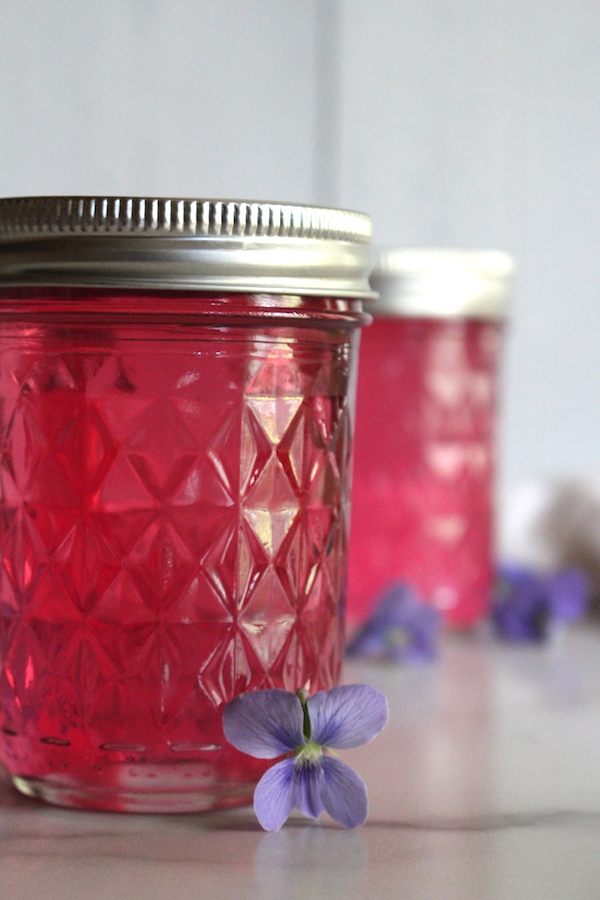
Ways to Use Violets
Looking for more ways to use violets?
- Candied Violets
- Violet Leaf Lymphatic Salve
- Wild Violet Sugar Cookies
- Wild Violet Honey Butter
- Wild Violet Vinegar
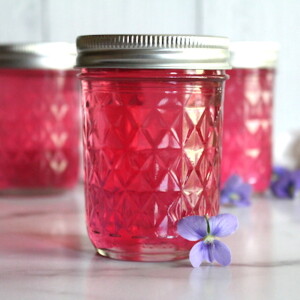
Violet Jelly
Ingredients
- 2 cups Wild Violet Flowers
- 4 Cups Water
- 1/4 Cup Lemon Juice, bottled if canning
- 1 box Powdered pectin, 1.75 oz Pectin or 6 Tbsp. (Such as Sure-Jell)
- 4 Cups Sugar
Instructions
- If canning, prepare a water bath canner before beginning. Skip this step for a refrigerator or freezer jelly.
- Bring 4 cups of water to a boil and pour it over 2 cups of loosely packed violet flowers. Allow the mixture to steep for 15 to 20 minutes to make a violet tea.
- Add 1/4 cup lemon juice and strain the flowers from the tea. You should have roughly 4 cups of pink liquid at this point (as the flowers will be slightly wet and keep some of the liquid, even if squeezed out).
- Pour the violet tea and lemon mixture into a saucepan and stir in the powdered pectin. Bring this mixture to a boil and boil hard for 1 minute.
- Add the sugar (don’t add it before this point or the jelly won’t gel). Stir to fully incorporate and bring the mixture back to a hard boil for 1 minute.
- Ladle into prepared jelly jars, leaving 1/4 inch headspace, and seal with 2 part lids.
- If canning, process the jars in a water bath canner for 10 minutes.
- If not canned, the jelly should be stored in the refrigerator and used within a few weeks. Properly canned in a water bath canner, sealed jars should keep at room temperature on the pantry shelf for at least 12 months.
Notes
Nutrition
Nutrition information is automatically calculated, so should only be used as an approximation.
More Wild Foraged Preserves
Looking for more ways to preserve wild foraged treats?
More Easy Homemade Preserves for Spring
Preserving more than just violets this spring?
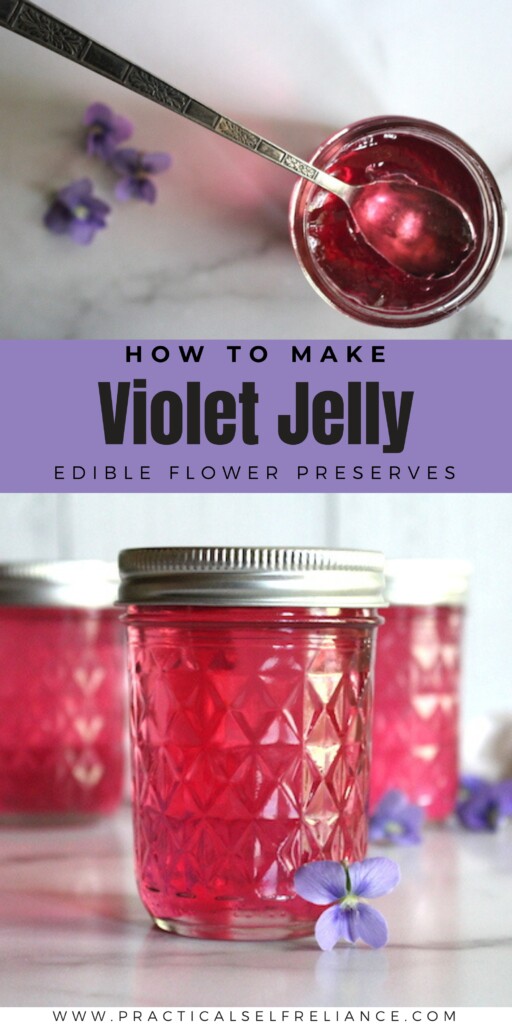
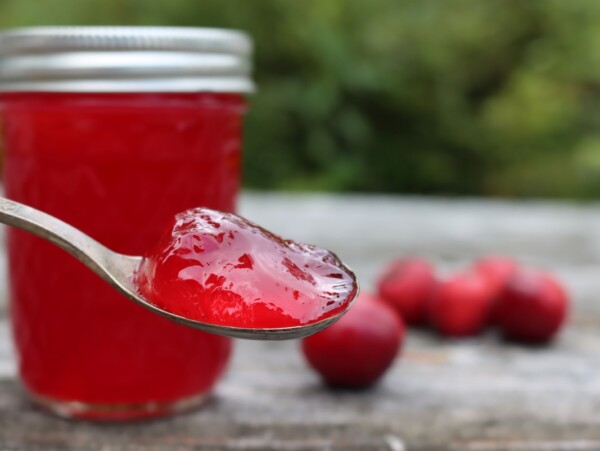
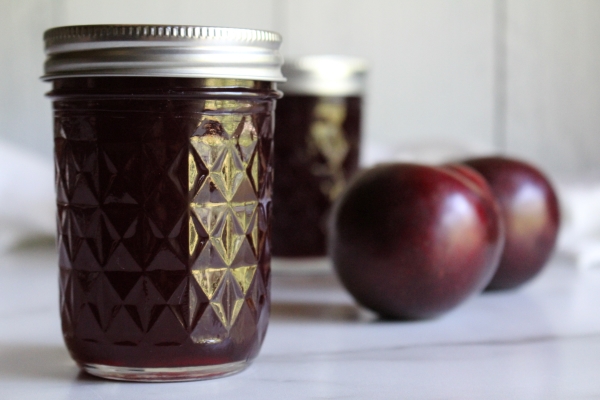
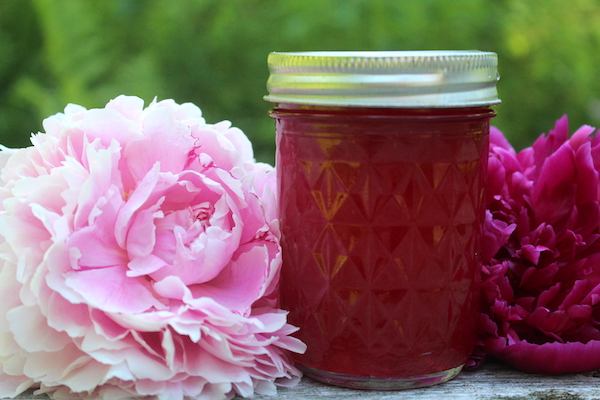
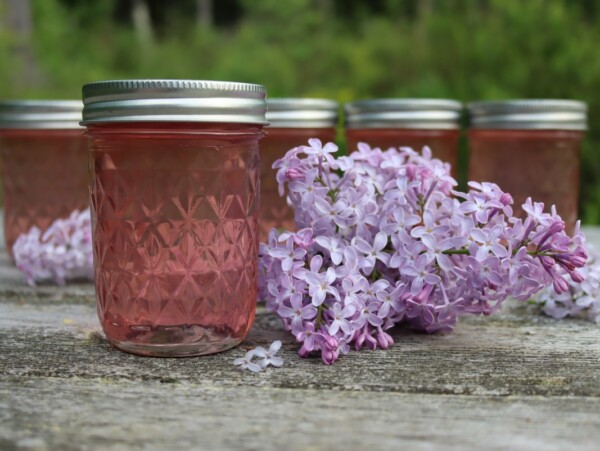
Looking forward to finally making violet jelly. However, I am dealing with back issues so my stamina is significantly decreased. Is it possible to pick the flowers and make the tea and store in frig to make jelly the next day? Thank you!
Yes definitely! Once you have the flowers, you do want to make the tea immediately as they start to degrade quickly, but you can keep the tea in the fridge for 3 to 4 days if need be before making the jelly. Enjoy!
Quick question … should the just-picked violets be rinsed before pouring the boiling water over them? Maybe I missed it but it seems as if they should be cleaned somehow. Can’t wait to try this jelly! Thanks!
That’s up to you. Ours are pretty clean, and we pick over them by hand, but you can rinse them if you’d like.
Just found your website and enjoying all your ideas , recipes and blog. I live in England and have a lot of rhubarb and violets growing in my back garden. Please could you give me the metric conversion to the quarts/ cups as when I look online, I am not getting the same conversion… Do you put the filled jars into a large saucepan and boil for X time? Sterilize jars in the oven too?. Thank you Nicky
I’m sorry but we don’t have metric conversions. I would just use the information that you find online. It should be accurate enough. If you end up with a jar that isn’t completely full you can simply put it in the fridge to use up immediately. The jars do not need to be sterilized as long as the processing time is over 10 minutes. We do have a post here for beginner waterbath canning. https://practicalselfreliance.com/water-bath-canning-beginners/ It is not necessary to use a water bath canner as long as you have a pot that is large enough to cover the jars appropriately and you want to be sure to not put the jars directly on the bottom of the pot.
Thanks for the Violet Jelly recipe Ashley. Our violets are ready here in East TN (late March) and I whipped up a delicious batch. Your recipe is most appreciated and delicious. Best regards from the DoubleD Farm in New Tazewell, TN.
You’re very welcome. So glad you enjoyed the recipe.
I believe there’s a typo: Could you please consider correcting the notes for this excellent and easy recipe to state 1 teaspoon of citric acid? Thank you.
Yes we will try to get that corrected. Thank you.
Thanks for this recipe! I’m going out to pick violets now.
Question: if I’m using citric acid, do I still need to add the volume of 1/4 cup water that would normally be part of the lemon juice? Thanks for this delicious, old-time recipe.
No it’s not necessary.
Hi Ashley
Thanks for al the wonderful knowledge that you are. I am starting a homestead here in France [but I am from the Netherlands] and love to read your blog though plants differ but the idea behind all this certainly not. About the violet jelly. I wonder if you can use agar agar to make the jelly? With many greetings
I’m not familiar with that plant. Do you have a scientific name?
Can you tell me if the flowers can be frozen, and if so how to do that.
Thanks,
Bridgett
If I were going to freeze them, I would probably put them in a little water first and then freeze that.
Just made this jelly for the first time last night. It tastes delicious! My color is fainter than your picture’s, and the jelly is less translucent than yours. Any idea what might have caused that? I did use low-sugar pectin. It is still gorgeous and delicious, just curious why it would have turned out different. Thank you!
It may be the pectin. I have heard several people say that the brand of pectin can affect the final color.
The relentless storms here in California have brought about the most amazing show of wild violets.
I just made this jelly today, after years of thinking about doing it.
Thanks for the recipe.
You’re very welcome. So glad you enjoyed the recipe.
This is the third year I’ve made this jelly. I just wanted to say to make sure to use the sure-jell pectin as I’ve tried it with the Ball pectins and it doesn’t retain the color, one of the best things about this jelly. My daughter is named Violet and I make this every year in honor of her. Thanks for sharing this recipe.
You’re welcome. We’re so glad you enjoyed the recipe.
Hi Ashley,
I accidentally canned with fresh lemon juice vs. bottled. Is this batch safe to consume? Or should I eat it within a certain time frame? I’m so sad about this.
In this particular case, fresh lemon juice should be totally fine for canning. There is more than enough lemon juice in there to bring the pH down, and even if by chance it’s not quite as acidic as bottled (which happens occasionally, but not all the time), it’d still be perfectly fine. Pectin actually has citric acid added in to correct for this as well, so many recipes say you don’t need the lemon juice at all for safe canning. That’s just a bonus for extra caution, and given that, fresh is totally fine.
Made this jelly yesterday and it looks beautiful. How long does it usually take for yours to set? Mine has been sitting for about 16 hours and is still liquid.
It can sometimes take 24 to 48 hours to set.
I tried this recipe this weekend and honestly who knew the jelly would be so delicious. I mean bees make honey from flowers and that is yummy. So why wouldn’t this jelly taste good? It’s honestly so very sad how disconnected we are from the Earth. I’m trying to find my way back to it and your writing is helping me explore. Thank you for the wonderful information, great recipe, and helping me live completely in this world and not just on it.
You’re very welcome. We’re so glad you enjoyed the jelly. I agree with you that it is sad but hopefully we can all do our part to change that.
Can you add fresh blossoms to each jar before sealing and processing to make it look pretty?
Thank you, Margie
That sounds like a great idea. I haven’t ever actually tried it but I am guessing that they won’t stay very pretty through the canning process but let us know if you decide to try it.
Mine didn’t set up, but it was sure pretty to look at
I’m so sorry it didn’t set up for you.